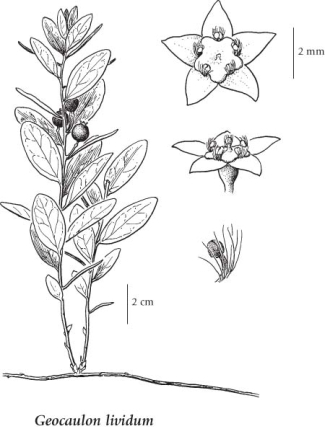Geocaulon lividum (Richardson) Fernald
false toad-flax (false toadflax; northern comandra)
Santalaceae (Christmas Mistletoe family)
Introduction to Vascular Plants
false toad-flax (false toadflax; northern comandra)
Santalaceae (Christmas Mistletoe family)
Introduction to Vascular Plants
Species Information
General:
Perennial parasitic herb from widespread rhizomes; stems erect, 1 to several in a clump, simple, 10-20 cm tall.
Leaves:
Basal leaves lacking; stem leaves alternate, entire, short-stalked, narrow to widely egg-shaped, 1.5-4 cm long.
Flowers:
Inflorescence of axillary or subterminal cymose clusters of 3 greenish-purple, apetalous flowers with the lateral pair soon deciduous, leaving an elongated terminal flower; calyces bell-shaped with 5 triangular lobes 1.5 mm long and spreading; stamens 0.5 mm long.
Fruits:
Drupe-like, round, fleshy, red, 5-10 mm wide.
Illustration

If more than one illustration is available for a species (e.g., separate illustrations were provided for two subspecies) then links to the separate images will be provided below. Note that individual subspecies or varietal illustrations are not always available.
Illustration Source: The Illustrated Flora of British Columbia
Ecology
Ecological Framework for Geocaulon lividum
The table below shows the species-specific information calculated from
original data (BEC database) provided by the BC Ministry of Forests and Range.
(Updated August, 2013)
The table below shows the species-specific information calculated from
original data (BEC database) provided by the BC Ministry of Forests and Range.
(Updated August, 2013)
| Site Information |
Value / Class |
||
|
Avg |
Min |
Max |
|
| Elevation
(metres) |
860 | 0 | 2160 |
| Slope
Gradient (%) |
10 | 0 | 103 |
|
Aspect (degrees) |
357 | 0 | 360 |
| Soil
Moisture Regime (SMR) [0 - very xeric; 4 - mesic; 8 - hydric] |
3 | 0 | 8 |
| Modal
Nutrient Regime
Class |
C | ||
| #
of field plots species was recorded in: |
2031 | ||
| Modal
BEC Zone Class |
SBS | ||
|
All BEC Zones (# of stations/zone) species was recorded in |
AT(1), BAFA(1), BG(2), BWBS(596), CWH(15), ESSF(45), ICH(109), IDF(125), MS(102), PP(3), SBPS(150), SBS(729), SWB(56) | ||
|
Source:
Klinkenberg 2013
|
|||
Habitat and Range
Dry to mesic forests and bogs in the montane and subalpine zones; common throughout BC in and E of the Coast-Cascade Mountains except rare on the N coast and SC BC; N to AK, YT and NT, E to NF and S to ME, NY, MI, WI, MN, MT, ID and WA.Status Information
Synonyms
Synonyms and Alternate Names:
Comandra lividum Richardson